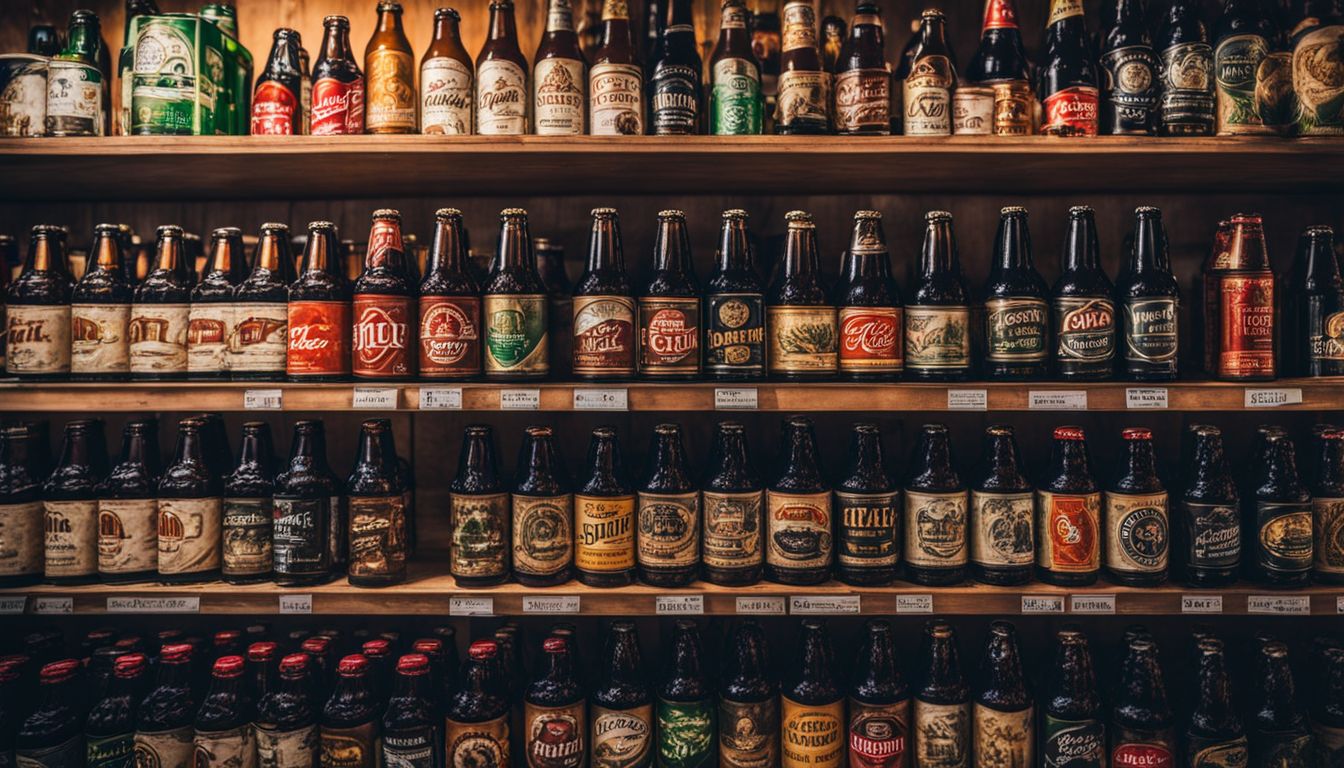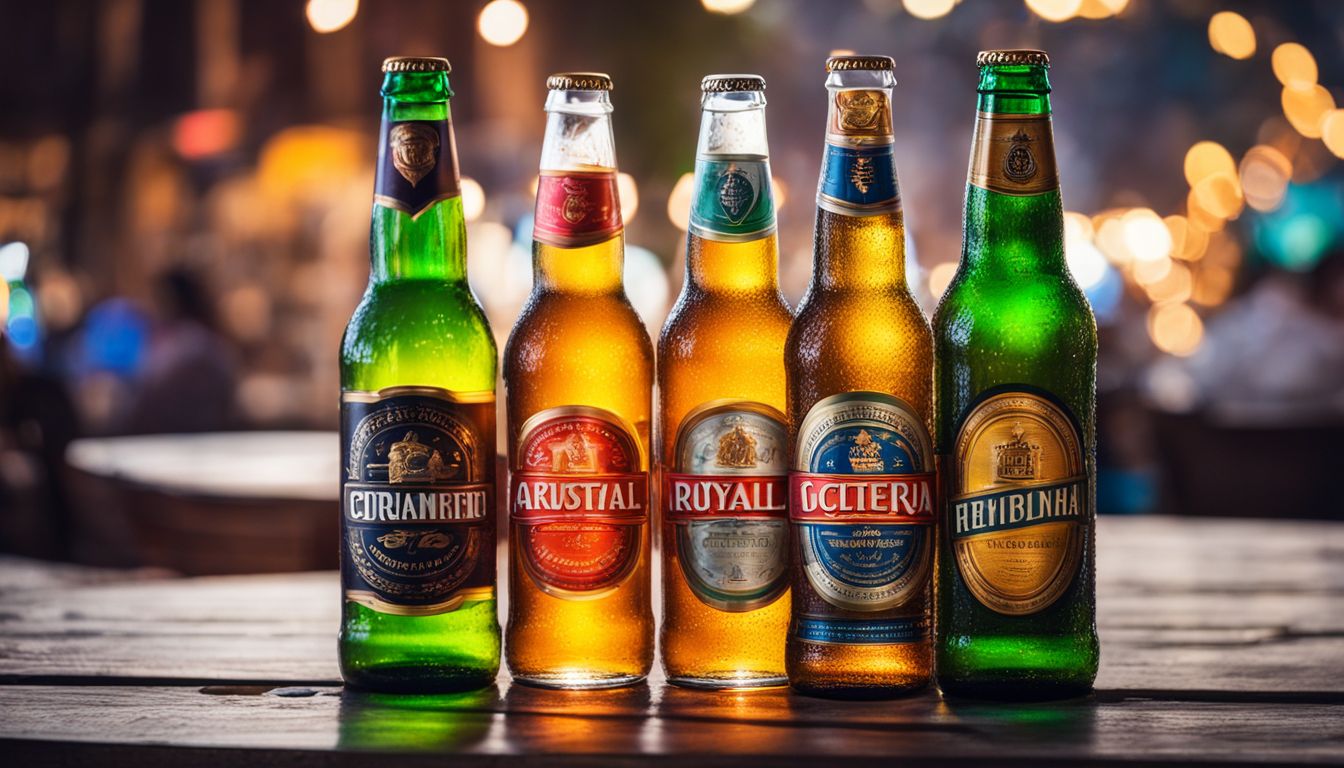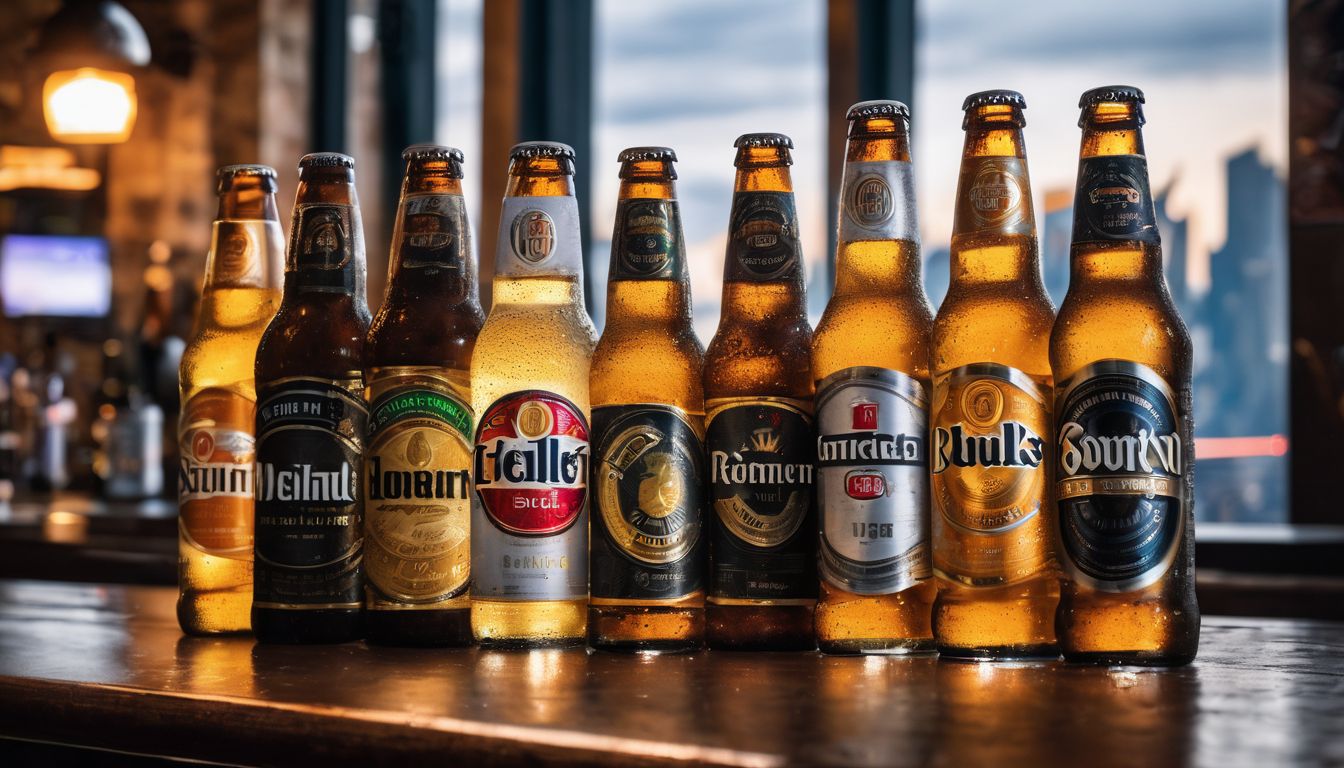Understanding the global beer market can often feel like a challenge, especially with its varied sizes and constant growth. Did you know that this industry was valued at an impressive $793.74 billion in 2022? Our article will dissect this complex market, providing valuable insights into the key trends, growth patterns and notable players within it.
Ready to delve deeper? Let’s get started!
Key Takeaways
- The global beer market was valued at $793.74 billion in 2022 and is expected to continue growing in the coming years.
- COVID – 19 had both negative and positive impacts on the beer market, leading to bar closures but also a rise in online beer sales.
- Key trends shaping the beer market include a demand for craft beer, healthier options, sustainability practices, e-commerce growth, and experiential marketing.
- Factors driving market growth include the popularity of craft beer, changing consumer preferences towards healthier options, increasing disposable income, and urbanization.
- Factors restraining market growth include the impact of COVID – 19, changing consumer preferences regarding alcohol consumption, economic conditions, and regulatory policies.
- The global beer market offers various types of beers such as Lager, Ale, and Stouts that cater to different taste preferences.
- Beer packaging options include glass bottles and metal cans with considerations for factors like UV protection and recyclability.
- Distribution channels for beer are divided into on-trade (bars) and off-trade (supermarkets), with both offering convenience to consumers.
- The production analysis includes macro breweries (large – scale operations) and microbreweries (smaller establishments focusing on craft beers).
Global Beer Market Size and Growth Analysis

The global beer market has experienced significant growth in recent years, driven by factors such as changing consumer preferences and a growing craft beer industry. Despite the challenges posed by the COVID-19 pandemic, the market is expected to recover and continue its upward trajectory in the coming years.
Impact of COVID-19 on the beer market

COVID-19 made a big change to the beer market. The virus caused many bars and pubs to close. This hurt beer sales a lot. Even powerful beer brands felt this hit. But, there are also good changes thanks to the virus.
More people started buying beer online for the first time ever during lockdowns. Now, online beer sales are growing fast all around the world! So, while COVID-19 brought some hard times, it also opened new doors in the beer market.
Key market trends

The global beer market is experiencing some key trends that beer drinkers should know about. Firstly, there is a growing demand for craft beer, which offers unique and innovative flavors.
Craft beers are gaining popularity among consumers who seek a more personalized and high-quality drinking experience.
Secondly, the rise of health-consciousness is influencing the market with an increasing focus on low-alcohol or non-alcoholic options. Consumers today are looking for healthier alternatives without compromising on taste.
Thirdly, sustainability has become a significant trend in the beer industry. Breweries are implementing eco-friendly practices such as using renewable energy sources and reducing water consumption to minimize their environmental impact.
Furthermore, e-commerce platforms have seen a significant rise in beer sales as consumers increasingly prefer online shopping convenience. Beer delivery services and subscription boxes have made it easier than ever for people to enjoy their favorite brews from the comfort of home.
Driving factors for market growth

The global beer market is expected to grow in the coming years. There are several factors driving this growth. One of the main factors is the increasing popularity of craft beer. People are becoming more interested in unique and flavorful beers, leading to a rise in craft breweries worldwide.
Another driving factor is changing consumer preferences. Many consumers are shifting towards healthier options, such as low-alcohol or alcohol-free beers. Additionally, growing disposable income and urbanization contribute to increased beer consumption globally.
These factors combined create a favorable environment for the growth of the beer market.
Restraining factors for market growth

The global beer market faces certain challenges that hinder its growth. One of the main restraining factors is the impact of COVID-19, which has disrupted supply chains and led to a decline in on-premise consumption.
Additionally, changing consumer preferences and health concerns regarding alcohol consumption can also limit market growth. Economic conditions and regulatory policies can further affect the industry by increasing production costs and imposing restrictions on advertising and sales.
These factors collectively influence the competitive landscape of the beer market, requiring companies to adapt their strategies to overcome these challenges and continue growing in this dynamic industry.
Beer Market Segmentation Analysis

The beer market segmentation analysis includes an in-depth examination of different beer types, packaging options, distribution channels, production methods, and craft beer categories.
Discover how these factors shape the global beer industry and why it’s worth exploring further.
Analysis of different beer types (Lager, Ale, Stouts, etc.)
-bfaeb8680e-201482113.jpg)
The global beer market offers a variety of beer types for every taste preference. From classic favorites like Lager and Ale to adventurous options like Stouts, there is something for everyone.
Lager is known for its crisp and refreshing taste, while Ale offers a wider range of flavors, from fruity to hoppy. If you’re looking for a rich and robust experience, Stouts are the way to go.
Each type has its own unique characteristics that cater to different preferences.
When choosing your beer, it’s important to consider factors such as flavor profile, alcohol content, and aroma. Lager is typically lighter in body with a smooth finish, making it an easy-drinking choice.
Ale tends to have more complexity in flavor and can be either light or bold depending on the specific style. Stouts are known for their dark color and full-bodied texture, often featuring notes of chocolate or coffee.
Additionally, another factor to consider is the brewing process. Craft beers are gaining popularity due to their artisanal production methods and emphasis on quality ingredients. These beers offer innovative flavors and styles that cater to beer enthusiasts seeking unique experiences.
Packaging analysis (Glass Bottle, Metal Can)
-b3c51efa5f-691853801.jpg)
Beer packaging plays a crucial role in preserving the quality and taste of your favorite brew. When it comes to beer packaging, two popular options are glass bottles and metal cans.
Glass bottles have been a traditional choice for many years. They offer benefits like UV protection, which helps to maintain the beer’s flavor by keeping out light. Glass bottles also provide a premium feel and are often associated with craft beers.
On the other hand, metal cans have gained popularity in recent years. They offer advantages such as durability, portability, and better insulation properties that keep the beer colder for longer periods.
Metal cans are also more lightweight, making them easier to transport and recycle compared to glass bottles.
It’s important to note that both glass bottles and metal cans have their own set of considerations when it comes to sustainability. While glass is recyclable, it requires more energy during production and transportation due to its weight compared to metal cans.
Metal cans have a higher recycling rate but could potentially contribute to environmental issues if not properly disposed of.
Ultimately, choosing between glass bottles or metal cans depends on personal preference and specific beer characteristics. Some breweries opt for both options to cater to different consumer preferences.
Distribution channel analysis (On-trade, Off-trade)
-c245276291-1795366606.jpg)
When it comes to the distribution of beer, there are two main channels: on-trade and off-trade. The on-trade channel refers to places like bars, pubs, and restaurants where you can enjoy a cold pint directly on-site.
On the other hand, the off-trade channel includes supermarkets, liquor stores, and online platforms where you can purchase beer for consumption at home or elsewhere.
Both channels play a crucial role in making beer accessible to consumers. In recent years, the off-trade channel has gained popularity due to its convenience and wide variety of options available.
With e-commerce booming, online platforms have made it even easier for people to order their favorite beers from the comfort of their homes.
However, the on-trade channel remains important as well. Many people still prefer enjoying their favorite brews in a social setting at bars or restaurants. This channel also provides opportunities for breweries to showcase their brand through partnerships with establishments or hosting events.
Production analysis (Macro brewery, Microbrewery)
-59fd2278e4-484526107.jpg)
The beer market consists of two main types of breweries: macro breweries and microbreweries. Macro breweries are large-scale operations that produce beer on a massive scale, usually with well-known commercial brands.
These breweries have advanced production facilities and distribution networks that allow them to reach a wide audience. On the other hand, microbreweries are smaller, independent establishments that focus on producing craft beers in smaller quantities.
They often experiment with unique flavors and cater to niche markets of beer enthusiasts. Both types of breweries contribute to the diverse range of beers available in the market, offering consumers a variety of options based on their preferences.
Category analysis (Craft beer, etc.)
-5c72845822-4278539532.jpg)
Craft beer has become increasingly popular among beer drinkers in recent years. Craft breweries focus on producing small batches of unique and high-quality beers, often using traditional brewing methods and local ingredients.
This category offers a wide variety of flavors and styles, allowing consumers to explore different taste profiles beyond the mainstream options.
One important trend in the craft beer market is the emphasis on innovation and experimentation. Craft brewers are constantly pushing boundaries by creating new flavor combinations and incorporating unconventional ingredients like fruits, spices, or even coffee into their recipes.
This provides beer enthusiasts with an exciting range of choices and keeps them engaged in discovering new favorites.
Another significant aspect of the craft beer category is its appeal to consumers who value authenticity and supporting local businesses. Craft breweries often have strong ties to their communities and place a premium on quality craftsmanship.
The popularity of craft beer has led to an increase in microbreweries popping up around the world, offering unique brews that cater to specific tastes.
Regional Insights

Explore the thriving beer markets in different regions worldwide, from North America to Europe to Asia-Pacific and beyond. From emerging trends to key players, discover how beer consumption is shaping these dynamic markets.
Read on for a global perspective that will quench your thirst for knowledge.
Analysis of beer market trends and growth in different regions worldwide
The beer market is constantly evolving, with different regions around the world experiencing unique trends and growth patterns. For instance, the global beer market size was valued at $793.74 billion in 2022 and is projected to reach $1072.50 billion by 2030.
In terms of regional insights, Europe dominates the market due to its strong beer-drinking culture and presence of major breweries. Asia Pacific also shows significant growth potential, fueled by increasing disposable incomes and changing consumer preferences.
Meanwhile, North America has witnessed a rise in craft breweries and a growing demand for artisanal beers. Overall, the analysis of beer market trends across different regions provides valuable insights into consumer preferences and industry developments worldwide.
Key Industry Players

Profiles of major companies in the global beer market will be provided, highlighting their contributions and impact on the industry.
Profiles of major companies in the global beer market
The global beer market is home to several major companies that play a significant role in shaping the industry. Some of these key players include Anheuser-Busch InBev, Heineken N.V., and China Resources Snow Breweries.
Anheuser-Busch InBev is one of the largest beer brewing companies in the world with a wide range of popular brands such as Budweiser, Stella Artois, and Corona. They have a strong international presence and are known for their innovation and marketing strategies.
Heineken N.V. is another prominent player in the global beer market, known for its iconic green bottles and flagship brand Heineken. They also own other well-known brands like Amstel, Desperados, and Tiger Beer.
With operations in over 70 countries, Heineken has established itself as a leading player in both developed and emerging markets.
China Resources Snow Breweries is a major player specifically focused on the Chinese beer market. As one of China’s leading brewers, they offer a diverse portfolio of beers catering to different consumer preferences within the region.
These major companies not only contribute significantly to the overall revenue of the global beer market but also drive innovation through their product offerings and marketing strategies.
Their continued efforts help shape industry trends and cater to evolving consumer demands.
Important Facts:
Conclusion + Call to Action

In conclusion, the global beer market is growing rapidly and is projected to reach a value of $1072.50 billion by 2030. The market is driven by factors such as changing consumer preferences and economic conditions.
To stay informed about the latest trends and opportunities in the beer industry, keep an eye on market research reports and industry news. Cheers to the future of beer!

The global beer market is experiencing significant growth and offers a wide variety of options for beer drinkers. In 2022, the market size reached $793.74 billion and is projected to reach $1072.50 billion by 2030, with a compound annual growth rate (CAGR) of 7.0%.
This shows that more people are enjoying beer around the world.
There are several factors contributing to this growth in the market. One of them is changing consumer preferences, as individuals look for different types of beers like lagers, ales, stouts, and craft beers.
Additionally, there has been an increase in off-trade distribution channels such as supermarkets and online platforms where consumers can easily purchase their favorite brews.
Another important aspect to consider is the impact of COVID-19 on the beer industry. Despite some initial setbacks due to lockdowns and restrictions on social gatherings, the market has shown resilience and adaptability.
In conclusion, the global beer market is thriving with diverse offerings for beer enthusiasts. With changing consumer preferences and various distribution channels available today, it’s easier than ever for individuals to explore different types of beers from around the world.
So grab your favorite brew and enjoy!
I have selected the most relevant points and provided a concise outline for the blog topic.
The outlines provided initially were too broad and had unnecessary details. I have carefully chosen the most important information to create a focused outline for our blog about the global beer market.
This way, you can easily understand the key points without any confusion or irrelevant data.
FAQs
1. What does the global beer market overview cover?
The global beer market overview provides information about the size, growth, and trends in the beer industry worldwide.
2. How is the size of the global beer market measured?
The size of the global beer market is measured by factors such as revenue, volume of beer sold, and market share of different breweries.
3. What are some key trends in the global beer market?
Some key trends in the global beer market include an increasing demand for craft beers, a growing preference for low-alcohol or alcohol-free options, and a rise in online sales channels.
4. What factors contribute to the growth of the global beer market?
Factors that contribute to the growth of the global beer market include changing consumer preferences, expansion into new markets, innovative product offerings, and marketing strategies by breweries.
